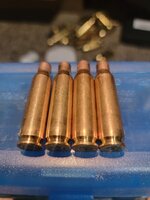Adam Gibbs
WKR
- Joined
- Aug 28, 2017
- Messages
- 579
Novice reloader, was sorting brass and noticed my 2x fired Norma brass has a ring around the case where 1x fired (first firing was factory loaded) doesn't have the ring. My load is book max but shows no pressure signs. Cases are FL sized
Is that ring always an indication of case head failure? I was suprised to see it after 2 firings. Any way to tell if it's actually separating? I've heard of the paperclip truck bit what exactly am I feeling for? Any help is appreciated.
Is that ring always an indication of case head failure? I was suprised to see it after 2 firings. Any way to tell if it's actually separating? I've heard of the paperclip truck bit what exactly am I feeling for? Any help is appreciated.

